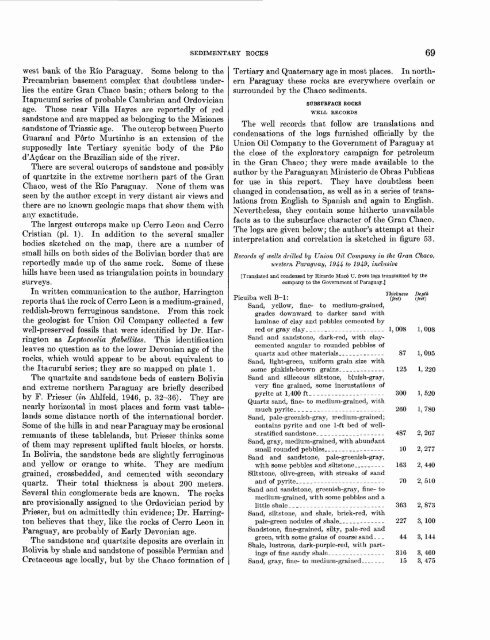Geology and Mineral Resources of Paraguay A Reconnaissance
Geology and Mineral Resources of Paraguay A Reconnaissance
Geology and Mineral Resources of Paraguay A Reconnaissance
- No tags were found...
You also want an ePaper? Increase the reach of your titles
YUMPU automatically turns print PDFs into web optimized ePapers that Google loves.
SEDIMENTARY ROCKS 69west bank <strong>of</strong> the Rio <strong>Paraguay</strong>. Some belong to thePrecambrian basement complex that doubtless underliesthe entire Gran Chaco basin; others belong to theItapucumi series <strong>of</strong> probable Cambrian <strong>and</strong> Ordovicianage. Those near Villa Hayes are reportedly <strong>of</strong> reds<strong>and</strong>stone <strong>and</strong> are mapped as belonging to the Misioness<strong>and</strong>stone <strong>of</strong> Triassic age. The outcrop between PuertoGuarani <strong>and</strong> P6rto Murtinho is an extension <strong>of</strong> thesupposedly late Tertiary syenitic body <strong>of</strong> the Paod'Agucar on the Brazilian side <strong>of</strong> the river.There are several outcrops <strong>of</strong> s<strong>and</strong>stone <strong>and</strong> possibly<strong>of</strong> quartzite in the extreme northern part <strong>of</strong> the GranChaco, west <strong>of</strong> the Rio <strong>Paraguay</strong>. None <strong>of</strong> them wasseen by the author except in very distant air views <strong>and</strong>there are no known geologic maps that show them withany exactitude.The largest outcrops make up Cerro Leon <strong>and</strong> CerroCristian (pi. 1). In addition to the several smallerbodies sketched on the map, there are a number <strong>of</strong>small hills on both sides <strong>of</strong> the Bolivian border that arereportedly made up <strong>of</strong> the same rock. Some <strong>of</strong> thesehills have been used as triangulation points in boundarysurveys.In written communication to the author, Harringtonreports that the rock <strong>of</strong> Cerro Leon is a medium-grained,reddish-brown ferruginous s<strong>and</strong>stone. From this rockthe geologist for Union Oil Company collected a fewwell-preserved fossils that were identified by Dr. Harrington as Leptocoelia flabellites. This identificationleaves no question as to the lower Devonian age <strong>of</strong> therocks, which would appear to be about equivalent tothe Itacurubi series; they are so mapped on plate 1.The quartzite <strong>and</strong> s<strong>and</strong>stone beds <strong>of</strong> eastern Bolivia<strong>and</strong> extreme northern <strong>Paraguay</strong> are briefly describedby F. Prieser (in Ahlfeld, 1946, p. 32-36). They arenearly horizontal in most places <strong>and</strong> form vast tablel<strong>and</strong>ssome distance north <strong>of</strong> the international border.Some <strong>of</strong> the hills in <strong>and</strong> near <strong>Paraguay</strong> maybe erosionalremnants <strong>of</strong> these tablel<strong>and</strong>s, but Prieser thinks some<strong>of</strong> them may represent uplifted fault blocks, or horsts.In Bolivia, the s<strong>and</strong>stone beds are slightly ferruginous<strong>and</strong> yellow or orange to white. They are mediumgrained, crossbedded, <strong>and</strong> cemented with secondaryquartz. Their total thickness is about 200 meters.Several thin conglomerate beds are known. The rocksare provisionally assigned to the Ordovician period byPrieser, but on admittedly thin evidence; Dr. Harringtonbelieves that they, like the rocks <strong>of</strong> Cerro Leon in<strong>Paraguay</strong>, are probably <strong>of</strong> Early Devonian age.The s<strong>and</strong>stone <strong>and</strong> quartzite deposits are overlain inBolivia by shale <strong>and</strong> s<strong>and</strong>stone <strong>of</strong> possible Permian <strong>and</strong>Cretaceous age locally, but by the Chaco formation <strong>of</strong>Tertiary <strong>and</strong> Quaternary age in most places. In northern<strong>Paraguay</strong> these rocks are everywhere overlain orsurrounded by the Chaco sediments.SUBSURFACE ROCKSWELL RECORDSThe well records that follow are translations <strong>and</strong>condensations <strong>of</strong> the logs furnished <strong>of</strong>ficially by theUnion Oil Company to the Government <strong>of</strong> <strong>Paraguay</strong> atthe close <strong>of</strong> the exploratory campaign for petroleumin the Gran Chaco; they were made available to theauthor by the <strong>Paraguay</strong>an Ministerio de Obras Publicasfor use in this report. They have doubtless beenchanged in condensation, as well as in a series <strong>of</strong> translationsfrom English to Spanish <strong>and</strong> again to English.Nevertheless, they contain some hitherto unavailablefacts as to the subsurface character <strong>of</strong> the Gran Chaco.The logs are given below; the author's attempt at theirinterpretation <strong>and</strong> correlation is sketched in figure 53.Records <strong>of</strong> wells drilled by Union Oil Company in the Gran Chaco,western <strong>Paraguay</strong>, 1944 to 1949, inclusive[Translated <strong>and</strong> condensed by Eicardo Mazo U. from logs transmitted by thecompany to the Government <strong>of</strong> <strong>Paraguay</strong>.]_. ., -Picuiba well B-l:Thickness(feet)Depth(feet)S<strong>and</strong>, yellow, fine- to medium-grained,grades downward to darker s<strong>and</strong> withlaminae <strong>of</strong> clay <strong>and</strong> pebbles cemented byred or gray clay_____.---------------- 1,008 1,008S<strong>and</strong> <strong>and</strong> s<strong>and</strong>stone, dark-red, with claycementedangular to rounded pebbles <strong>of</strong>quartz <strong>and</strong> other materials--___________ 87 1, 095S<strong>and</strong>, light-green, uniform grain size withsome pinkish-brown grains_____________ 125 1,220S<strong>and</strong> <strong>and</strong> siliceous siltstone, bluish-gray,very fine grained, some incrustations <strong>of</strong>pyrite at 1,400 ft_-_----------_------- 300 1,520Quartz s<strong>and</strong>, fine- to medium-grained, withmuchpyrite------------------------- 260 1,780S<strong>and</strong>, pale-greenish-gray, medium-grained;contains pyrite <strong>and</strong> one 1-ft bed <strong>of</strong> wellstratifieds<strong>and</strong>stone- __________________ 487 2,267S<strong>and</strong>, gray, medium-grained, with abundantsmall rounded pebbles.________________ 10 2,277S<strong>and</strong> <strong>and</strong> s<strong>and</strong>stone, pale-greenish-gray,with some pebbles <strong>and</strong> siltstone________ 163 2,440Siltstone, olive-green, with streaks <strong>of</strong> s<strong>and</strong><strong>and</strong> <strong>of</strong> pyrite ----------------------.- 70 2,510S<strong>and</strong> <strong>and</strong> s<strong>and</strong>stone, greenish-gray, fine- tomedium-grained, with some pebbles <strong>and</strong> alittle shale__.------------------------ 363 2,873S<strong>and</strong>, siltstone, <strong>and</strong> shale, brick-red, withpale-green nodules <strong>of</strong> shale_____________ 227 3, 100S<strong>and</strong>stone, fine-grained, silty, pale-red <strong>and</strong>green, with some grains <strong>of</strong> coarse s<strong>and</strong>_ _ _ 44 3, 144Shale, lustrous, dark-purple-red, with partings<strong>of</strong> fine s<strong>and</strong>y shale____-_-_-----__- 316 3,460S<strong>and</strong>, gray, fine- to medium-grained_____ 15 3, 475
















